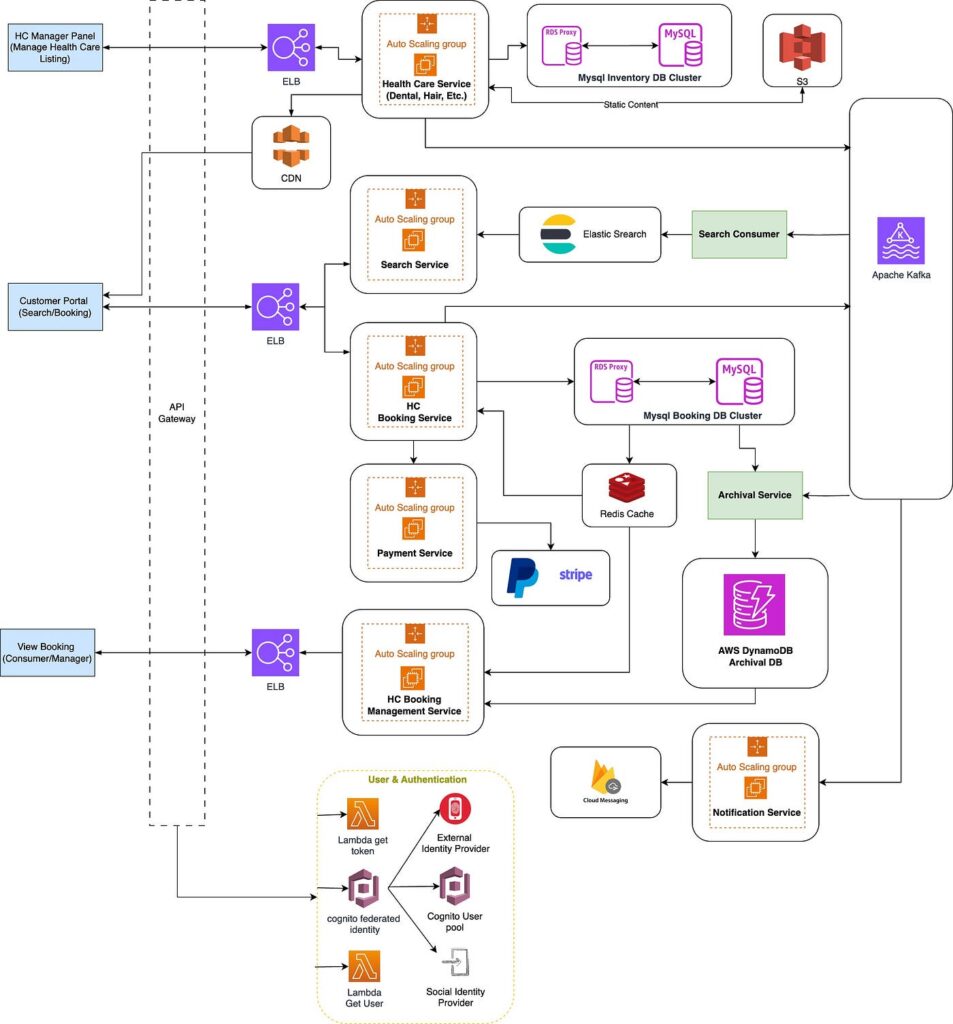Imagine a digital marketplace where healthcare providers can list their services and patients can easily find and book them. Let’s walk through how this system works, from start to finish.

The Healthcare Provider’s Journey
Let’s say, a dentist who wants to list their services on our platform. When they register and create their listing, something interesting happens behind the scenes. Their information doesn’t just go to one place — it follows a carefully designed path:
First, all their core information (services, prices, availability) lands in our primary database (MySQL Inventory Cluster). Think of this as the platform’s main record book. At the same time, any static content they upload — things like clinic photos or documentation — gets stored separately in S3, which acts like a dedicated media library.
But here’s where it gets clever: The moment this information is saved, it triggers an automatic update process. The system creates an event in Apache Kafka (think of it as a super-efficient message delivery system) that says “Hey, we’ve got new or updated provider information!” This message gets picked up by our search system, which automatically updates Elasticsearch with the new information. This means that the moment a healthcare provider updates anything about their listing, it’s immediately ready to be found by potential patients.
The Patient’s Search Experience
Now, let’s follow a patient’s journey. When someone visits the platform looking for a healthcare service, they don’t have to wait for the system to dig through the main database. Instead, their search query goes straight to our search service, which uses Elasticsearch to quickly find relevant matches. It’s like having a lightning-fast librarian who instantly knows where everything is and can even understand if you make a small typo in your search (that’s the fuzzy logic at work).
The Booking Flow: A Three-Act Story
The booking process is where things get really interesting. It’s designed like a three-act play:
Act 1: The Initial Booking
When a patient finds a service they want and initiates a booking, the system creates a new booking record in our booking database. Importantly, they don’t have to pay immediately — the system holds their spot while they arrange payment. This initial booking information is stored in our MySQL Booking Database Cluster.
Act 2: Active Booking Management
During this phase, the booking is “active” and needs to be easily accessible. The system uses Redis Cache as a super-fast temporary memory to keep track of these active bookings. Think of it like a receptionist’s desk where all current appointments are kept within easy reach. This means whether it’s the patient checking their booking, the healthcare provider reviewing their schedule, or the admin managing the system, they all get instant access to the information they need.
Act 3: The Archival Process
Here’s where the system gets really smart. Once a booking is complete — the patient has received their service, made their payment, and everything is finished — the system doesn’t keep this information in the active booking database. Instead, it moves it to DynamoDB, our archival database. This is like moving completed files from your desk to a filing cabinet — it keeps them safe and accessible but doesn’t clutter up the active system.
This archival process serves two crucial purposes:
- It keeps the active booking system lean and fast
- It maintains a complete history that can be accessed when needed
The Power of Auto-Scaling
Throughout this entire process, the system is constantly adjusting its resources to match demand. The Health Care Service, which manages all provider listings, runs in an Auto Scaling group. This means it automatically adds more computing power during busy periods (like when many providers are updating their listings simultaneously) and scales back during quieter times. It’s like having a building that can magically add or remove floors based on how many people need to use it.
Why This Design Matters
This architecture solves several critical challenges:
- Healthcare providers get their information published and updated instantly
- Patients can search and find services quickly and reliably
- Bookings are managed efficiently from start to finish
- The system stays fast and responsive even as it handles more and more data
- Historical data is preserved without slowing down current operations
It’s a bit like a well-choreographed dance where each component knows its part and works in harmony with the others. The result is a seamless experience for everyone involved — healthcare providers can manage their services efficiently, patients can find and book what they need easily, and administrators can keep everything running smoothly.
Part 2: Building a Scalable Healthcare Booking Platform (Part 2): Technical Process Overview
Part 3: Building a Scalable Healthcare Booking Platform (Part 3): Listing Searching Mechanism
Part 4: Building a Scalable Healthcare Booking Platform (Part 4): Role-Based Access Control